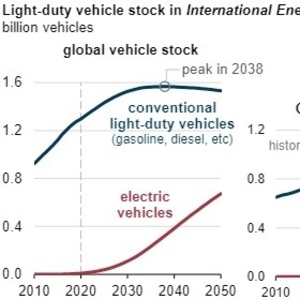EIA projects global conventional vehicle fleet will peak in 2038

October 26, 2021
BY U.S. Energy Information Administration
In our International Energy Outlook 2021, we estimate the global light-duty vehicle (LDV) fleet contained 1.31 billion vehicles in 2020, and we project this fleet will grow to 2.21 billion vehicles by 2050. We project electric vehicles (EVs)—any LDV with a charging plug—will grow from 0.7 percent of the global LDV fleet in 2020 to 31 percent in 2050, reaching 672 million vehicles. Significant growth in EV sales and shares of sales through the projection period results in the global conventional gasoline and diesel LDV fleet peaking in 2038.
We project that an increase in economic activity, population, and private mobility will result in more global LDVs through 2050. We project the population of non-OECD (Organization for Economic Cooperation and Development) countries will grow at over three times the population growth rate of OECD countries and that the non-OECD motorization rate will increase from 92 vehicles per thousand people to 173 vehicles per thousand people between 2020 and 2050. The OECD countries’ motorization rate remains around 530 vehicles per thousand people through the projection period. Because of this growth in population and motorization rates, we project the number of LDVs in non-OECD countries will surpass those in OECD countries in 2025.
The 2020 global LDV fleet primarily consists of conventional gasoline and diesel internal combustion engine vehicles, but sales of EVs are projected to grow due to recent technology and policy developments. In our International Energy Outlook 2021, EVs include both full battery, all-electric vehicles and plug-in hybrid electric vehicles that are primarily powered by liquid fuels when batteries are nearly depleted.
We project EV fleet shares will reach 34 percent in OECD countries and 28 percent in non-OECD countries by 2050. Although the conventional LDV fleet peaks in 2023 for OECD countries, faster growth in the non-OECD fleet results in nearly two-thirds of light-duty EVs being in non-OECD countries by 2050.
Advertisement
Advertisement
Advertisement
Advertisement
Related Stories
U.S. fuel ethanol capacity fell slightly in April, while biodiesel and renewable diesel capacity held steady, according to data released by the U.S. EIA on June 30. Feedstock consumption was down when compared to the previous month.
XCF Global Inc. on July 8 provided a production update on its flagship New Rise Reno facility, underscoring that the plant has successfully produced SAF, renewable diesel, and renewable naphtha during its initial ramp-up.
The U.S. EPA on July 8 hosted virtual public hearing to gather input on the agency’s recently released proposed rule to set 2026 and 2027 RFS RVOs. Members of the biofuel industry were among those to offer testimony during the event.
The U.S. exported 31,160.5 metric tons of biodiesel and biodiesel blends of B30 and greater in May, according to data released by the USDA Foreign Agricultural Service on July 3. Biodiesel imports were 2,226.2 metric tons for the month.
The USDA’s Risk Management Agency is implementing multiple changes to the Camelina pilot insurance program for the 2026 and succeeding crop years. The changes will expand coverage options and provide greater flexibility for producers.
Upcoming Events










